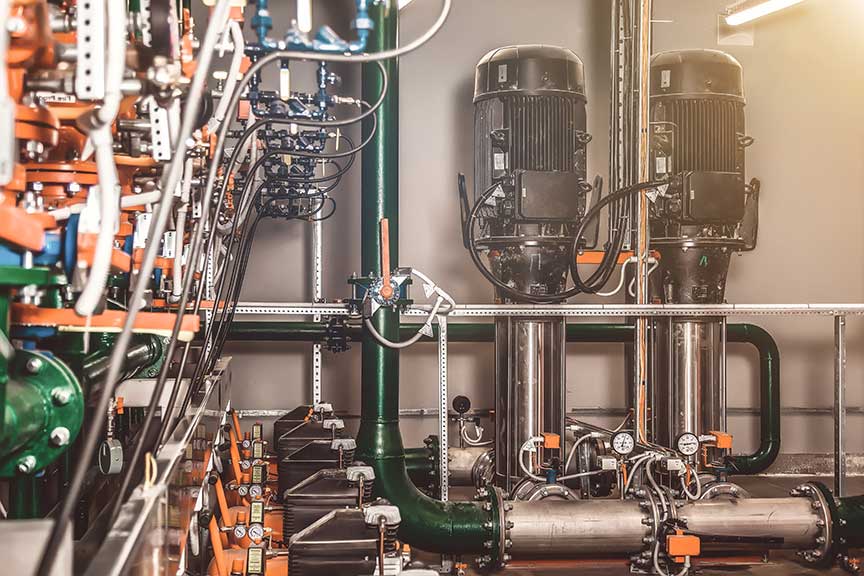A Brief History of Hydraulic Fluid Power
by Steven Post

People have been using fluids to power machinery for more than 2,000 years. While it started out with water, the high-pressure, fluid-powered system known as hydraulics has evolved to use additional types of fluid to maximize pressure and therefore maximize power.
Hydraulics play a critical role in powering machines, tools, and equipment used every day by manufacturing plants and tradespeople. The two people said to be pioneers in this technology are William George Armstrong and Joseph Brahah. Although it’s hard to pinpoint exactly who first came up with the idea, people like Blaise Pascal and Leonardo da Vinci have all written about this power potential.
If you’ve ever wondered how hydraulics came to play such a big role in daily life, here’s a brief history on this technology.
What is hydraulic power?
A system powered by hydraulics flows liquids through pipes, channels, or hoses, to create mechanical force. The main benefit is that the high pressure makes it easier to move heavy loads. The pressure created in a hydraulic system provides even more force than pneumatic, mechanical, and electrical systems.
Thanks to Pascal’s law, people figured out that liquids compress differently than air, which is why hydraulic systems are more powerful. Unlike air, applying pressure to a fluid in one area will distribute the pressure evenly. This makes hydraulic power powerful, predictable, and reliable.
How have hydraulics evolved over time?
In a nutshell, early hydraulics simply used water and gravity to create power. Contemporary hydraulics use specific types of fluid to generate power in extremely high-pressure systems.
Although the technology itself has evolved, so has safety. For instance, today’s couplers are leak-free, which makes a high-pressure system safer. Not only does it prevent fluid leaks, but good couplers can prevent hydraulic fluid injection injuries, which can be life-threatening. This is something ancient civilizations didn’t have to worry about.
Ancient hydraulics
In the beginning, hydraulics started out as a way to bring supplies of water to people, but evolved into more creative projects. For example, in the 6000s B.C., the Mesopotamians and Egyptians used hydraulics to irrigate their crops. In the 600s B.S., in Greece, people in the city of Samos (Pythagoreion today) created the Tunnel of Eupalinos aqueduct to supply the town with water. Considering they didn’t have a magnetic compass, any surveying instruments, topographical maps, or written math, this feat is a marvel.
Later on, in the 100s, Hero of Alexandria made the first steam engine called an “Aeolipile” using hydraulics. In the 300s, the Persians created the Shushtar Historical Hydraulic System. In the 900s, a water-powered flute player was invented. There were many other inventions that followed:
· 1795: Joseph Brahmah was given a patent for the first hydraulic press.
· 1882: The first hydroelectric power plant is created on the Fox River in Appleton, Wisconsin, and began operating on September 30.
· 1835: William George Armstrong creates the first water-powered rotary engine. This led to the invention of a piston engine used to divert the excess water pressure to power a hydraulic crane to load and unload ships.
· 1850-1851: William George Armstrong created the first hydraulic accumulator, which held liquid under pressure and bypassed the need for reservoirs. Armsrong’s technology was used to construct several bridges, including the Swing Bridge built over the River Tyne.
· 1947: The first experimental hydraulic fracturing treatment took place in the Hugoton gas field in Grant County, Kansas.
Contemporary hydraulics
In today’s society, hydraulic systems are used for a vast array of purposes. You can find this technology powering things you use in everyday life. For example:
· Gas pumps use hydraulic pressure to draw fuel from the underground storage tanks.
· Dishwashers need increased water pressure to blast off food and clean dishes thoroughly.
· Elevators. There are some elevators that use hydraulic power to move the cars and stop them.
· Cars use a hydraulic circuit for brakes. This is why it’s a sign that your brake system needs repair if your brake fluid gets low. You should never lose fluid from within a hydraulic system.
· Construction equipment. Machines like forklifts, backhoes, and tractors use hydraulics to power their control panels.
· Airplanes also use hydraulics to operate control panels.
Hydraulics make life easier
Now that you know a little bit more about the history of hydraulics and the important ways this technology is used, it’s easy to see that hydraulic power makes life easier. Without it, we wouldn’t have amusement park rides, snowplows, or even office chairs with adjustable height. It’s amazing to think that all of this came about because ancient civilizations needed to figure out how to get water to the main part of town.
 >
>